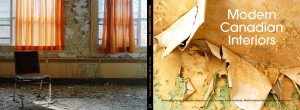Today I discovered a glowing review of the book Modern Canadian Interiors that the TLR Club (of which i am a member) published this May on the Hotshot* blog.
 And without further ado here is the review!
And without further ado here is the review!
Modern Canadian Interiors by Jacqueline Bennett
Modern Canadian Interiors (2010) is the first publication by the TLR Club to highlight a rich collection of photography and carefully executed research. The TLR Club (Twin Lens Reflex) consists of five photographers; Alejandro Valencia, Colin Savage, Kevin McBride, Martin Helmut Reis and Richelle Forsey.
An interesting and somewhat ironic name choice- Modern Canadian Interiors suggests an entirely different context than the works reveal. Readers may be surprised to learn the TLR Club’s collection of photography explores technically “vacant structures” and in some cases condemned buildings to expose a whole new world of still-life occurring behind the seemingly abandoned walls. There is a surprising wealth of interesting artifacts, graffiti, and spaces still obviously used by squatters, thrill seekers and the like, revealing that these buildings are anything but vacant.
What is not surprising is that the TLR Club members are much more than photographers; they are part of a larger community known as Urban Explorers, which by definition are, “ [people] who explore restricted urban areas such as abandonments, tunnels, roofs, construction sites, etc.” (www.urbanexplorers.net). In MCI viewers get a behind the scenes look into the many places in our communities that have been left to crumble in order to make room for “new” infrastructures and gentrification to take place. Andrew Shaver notes in his foreword that, “while there is a degree of activism that is evident in the choices of [the TLR Club’s] photographic subjects, theirs is an implicit, not explicit argument” (p. 7, A. Shaver) of social and economic urban decay.
Beyond the context of the MCI collection is the remarkable composition which beautifully highlights the thick textures of peeling paint, the varying degree of lighting that creeps in, and an assortment of items left behind that reference past occupants. Each page leads to a story greater than the last. An added feature for true art historians is found on the last pages which detail the histories and fate of each structure.
In conclusion, whether you are looking for beautiful conversation pieces, interested in the histories of abandoned buildings or a true thrill seeker at heart, this publication is sure to satisfy an array of audiences interested in Canadian photography at its best.
By: Jacqueline Bennett